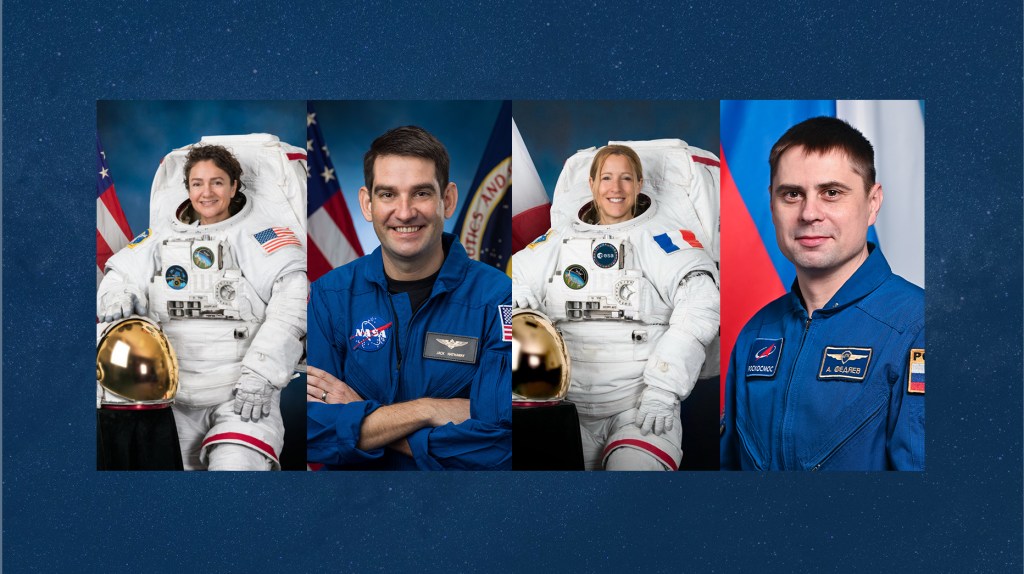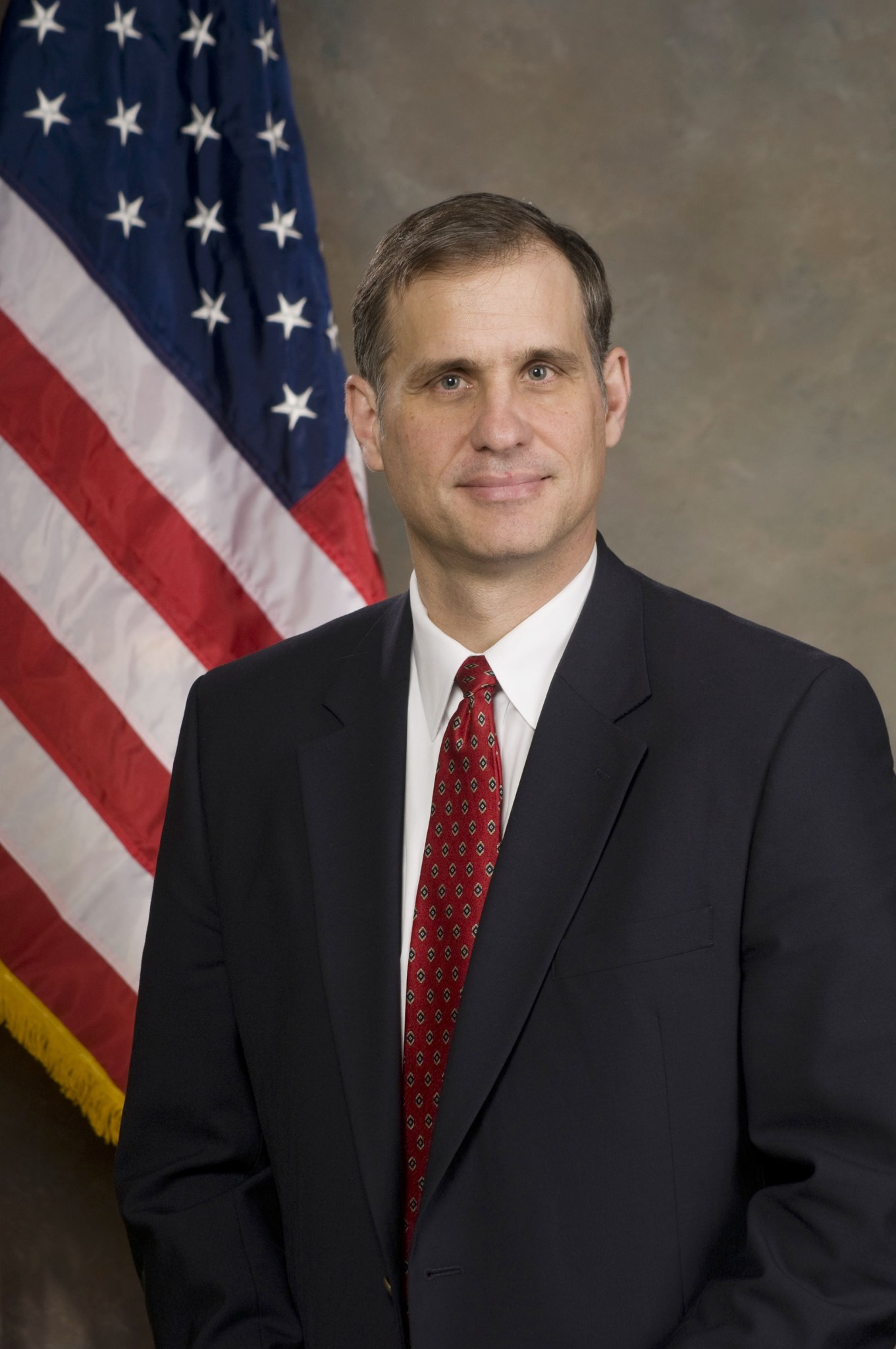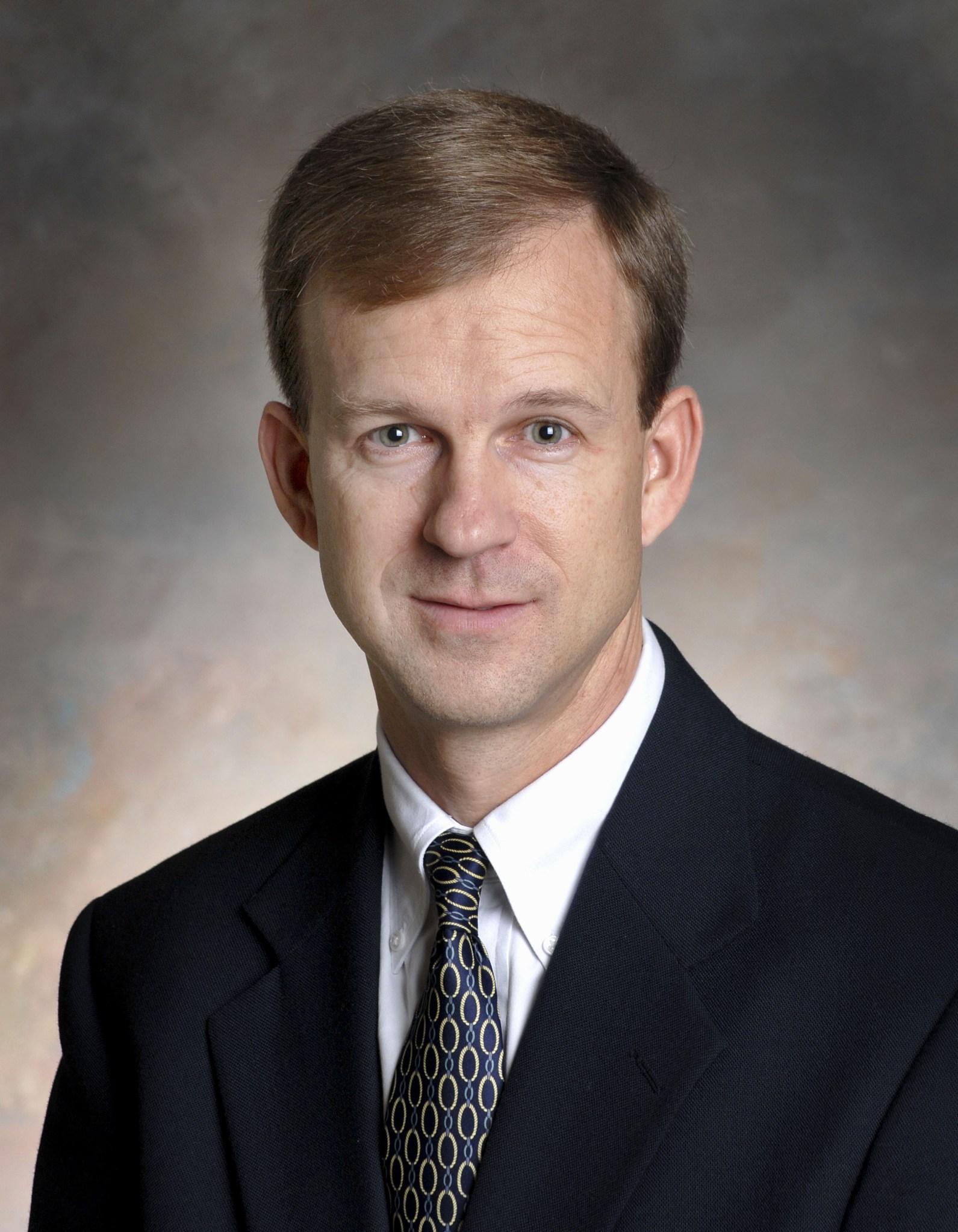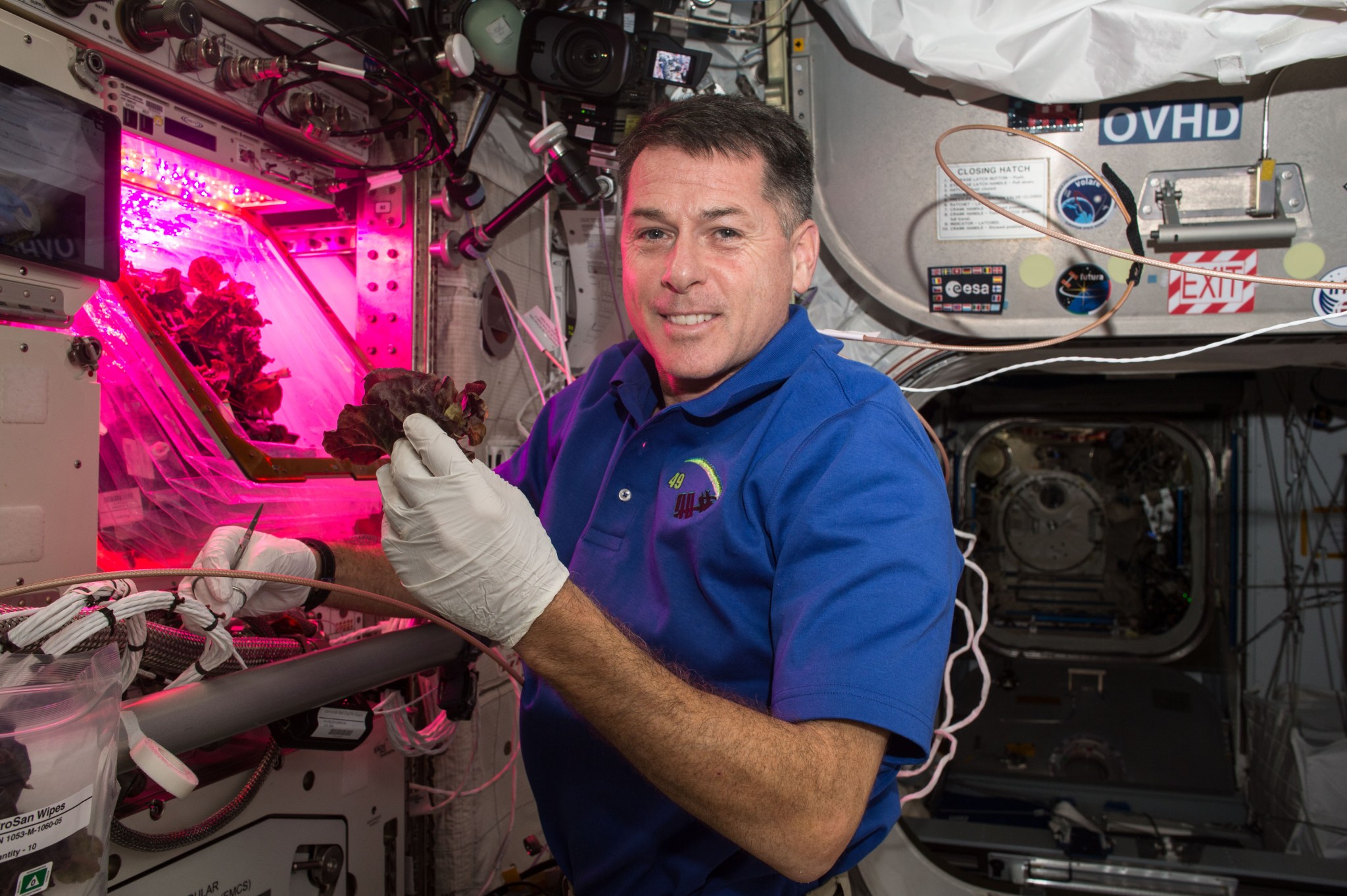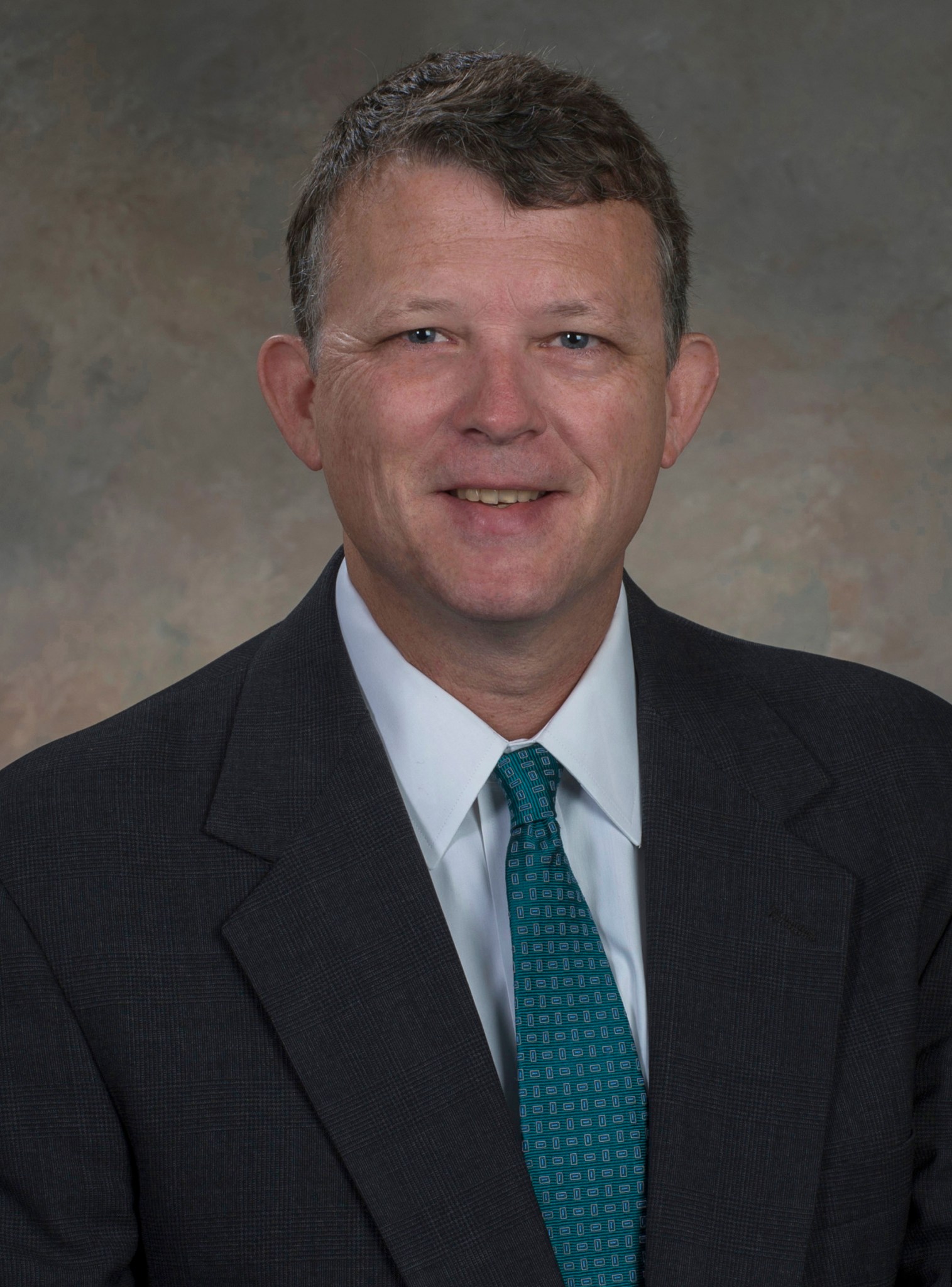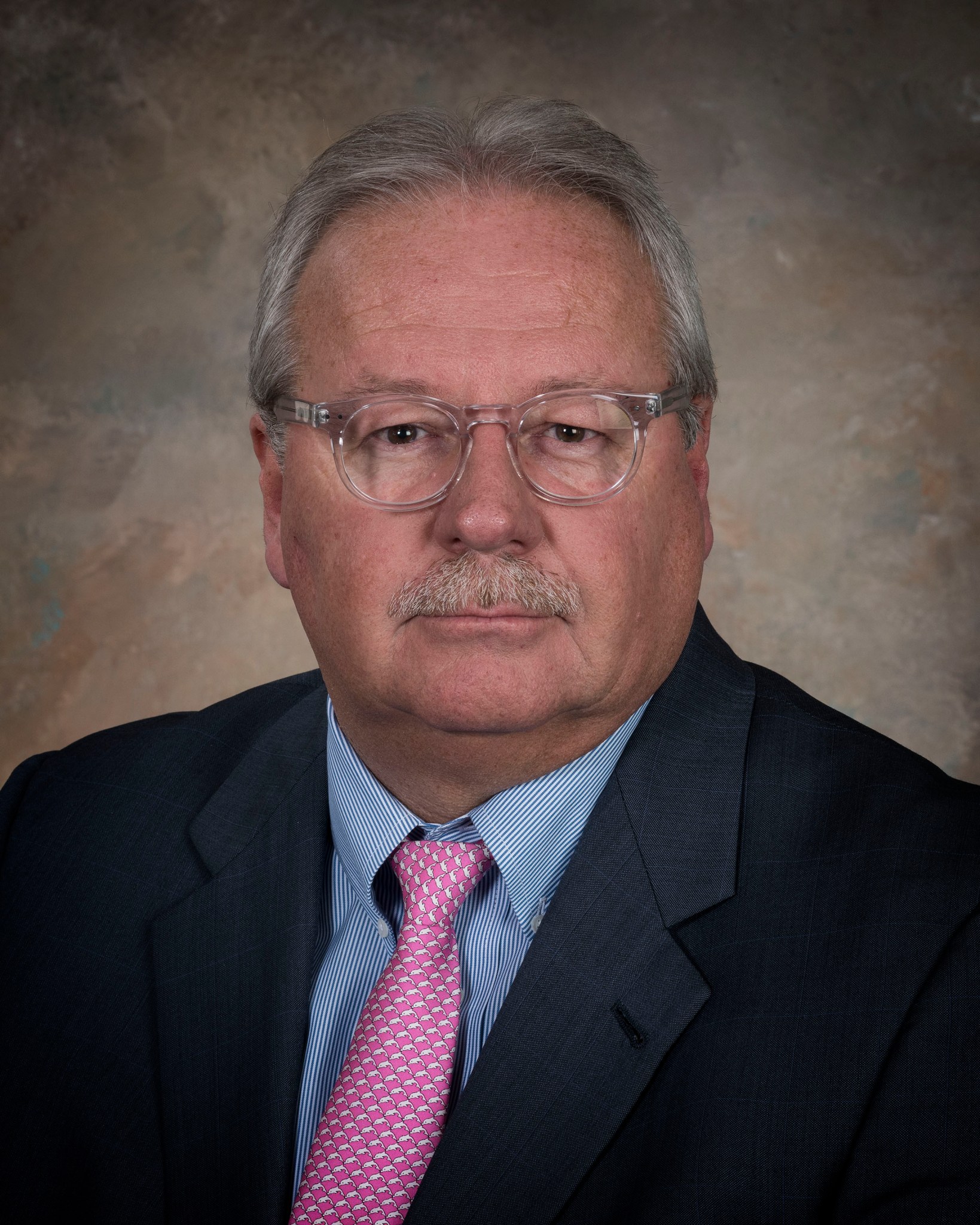In This Week’s Star
- Jonathan Pettus Named Marshall Center Associate Director
- Neil Rodgers Named Marshall’s Chief Information Officer
- Autumn Harvest on Space Station as Crew Enjoys Edible Crop
- Creech Named Manager of Spacecraft/Payload Integration and Evolution Office
- Show Some Love through CFC as You Count Down to the Holidays
- Marshall Tree-lighting Festivities Light Up 2016 Holiday Season
- Geminid Meteor Shower to Peak Dec 13; NASA Experts to Answer Questions Dec. 12
- Marshall’s John Vickers to Host Webinar, Discuss Additive Manufacturing’s Role at NASA
- This Week in NASA History: Apollo 17, Final Crewed Mission to the Moon, Launches — Dec. 7, 1972
Jonathan Pettus Named Marshall Center Associate Director
Jonathan Pettus has been named associate director of NASA’s Marshall Space Flight Center, where he will be responsible for leading the institutional operations of one of NASA’s largest field installations, with almost 6,000 civil service and contract personnel, an annual budget of approximately $2.5 billion, 4.5 million square feet of infrastructure and a broad spectrum of human spaceflight, science and technology development. Pettus replaces Robin Henderson who retires Dec. 31 after 33 years of service.
He most recently served as Marshall’s chief information officer, where he was responsible for leading the delivery and operations of information technology solutions to enable Marshall’s programs and mission, including the center’s computing infrastructure, communications networks and software systems.
Since joining NASA in 1991 as a computer engineer in Marshall’s Institutional and Program Support Office, Pettus has served in multiple roles of increasing leadership responsibility.
From 1997 to 2000, he served as implementation manager for the Integrated Financial Management Program, NASA’s previous computerized business management model. Pettus was then named manager of the Integrated Enterprise Management Program, where he planned and directed the overall integration of all program applications and led deployment of the program’s overall technical architecture.
Pettus was appointed to the Senior Executive Service — the personnel system covering top managerial positions in federal agencies — in 2002 as director of the NASA Integrated Enterprise Management Program Competency Center, an organization that supports NASA business systems for improving fiscal and management accountability.
He was selected as director of Marshall’s Office of the Chief Information Officer in 2005, where he supervised support services and security for the center’s expansive computer and communications networks. In 2007, Pettus was named chief information officer at NASA Headquarters, managing an integrated portfolio of IT Senior Executive Service infrastructure and applications supporting NASA’s human spaceflight, scientific and aeronautical programs. He returned to Marshall in 2009 to reassume his duties as the center’s chief information officer.
A native of Killen, Alabama, Pettus earned bachelor’s degrees in computer science and mathematics history in 1987 from the University of North Alabama in Florence and a master’s degree in computer science in 1995 from the University of Alabama in Huntsville.
He has received numerous awards and special recognitions, including a Meritorious Presidential Rank award for exemplary federal service in 2008. In 2005, Federal Computer Week magazine named Pettus to its “Federal 100,” an annual list of individuals who turn innovative technology ideas into real-life solutions. He has also been awarded the NASA Medal for Outstanding Leadership, NASA Medals for Exceptional Service and NASA Special Service Awards.
Pettus and his wife, Angela, live in Athens, Alabama, with their two children.
Neil Rodgers Named Marshall’s Chief Information Officer
Neil Rodgers has been named director of the Office of the Chief Information Officer at NASA’s Marshall Space Flight Center, where he will be responsible for leading the delivery and operations of information technology solutions to enable Marshall’s programs and mission, including the center’s computing infrastructure, communications networks and software systems. He will manage an annual IT budget of more than $370 million and oversee a workforce of 140 civil servants and more than 1,000 contract personnel.
Since 2014, Rodgers has served as deputy chief information officer for the Enterprise Integration Office, responsible for the operations and integration of common IT infrastructure and enterprise applications across NASA.
Rodgers joined NASA in 1989 as a computer engineer in Marshall’s Information Systems Services Office, where he managed the successful development and agency-wide implementation of the NASA Supply Management System.
In 1995, he was named project manager for Marshall’s Distributed Desktop Services, where he helped launch the center’s second-generation integrated office automation and engineering support environment. As team lead in the Information Systems Services Office from 1998 to 2000, Rodgers was a key member of the agency team responsible for the formulation of the Outsourcing Desktop Initiative for NASA and oversaw its subsequent implementation at Marshall.
Rodgers was named deputy manager of the Integrated Financial Management Program Integration Project in 2000, where he directed the integration of all the program’s projects with NASA’s existing applications and technical architecture. He became associate chief information officer for the Integrated Enterprise Management Program in 2006 and managed the program’s Competency Center, which provided implementation and ongoing operational support for all software related to the new business system.
He was appointed to the Senior Executive Service — the personnel system covering top managerial positions in federal agencies — in October 2006 as deputy chief information officer for the NASA Enterprise Applications Competency Center, a service delivery organization chartered with the development, integration, implementation and operation of agency-wide engineering, administrative and business applications.
He has received numerous awards during his NASA career, including NASA Certificates of Appreciation, NASA Special Service Awards, Sustained Superior Performance Awards, Group Achievement Awards and the Center Operations Directorate “MVP” Award in 2004.
Rodgers and his wife, Lisa, are natives and residents of Athens, Alabama, and have three daughters.
Autumn Harvest on Space Station as Crew Enjoys Edible Crop
NASA astronaut Shane Kimbrough harvests red romaine lettuce on the International Space Station Dec. 2 as part of the Veggie investigation. Six lettuce plants grow aboard the space station as part of the Veg-03 experiment. The study serves as a way to examine how edible plants respond to microgravity and as a demonstration of growing fresh food during missions to deep space. The harvest was solely for crew consumption, and the plan is to have four harvests total, with the final harvest targeted for the first of the new year. The yields from these harvests will be split between samples for science return and crew consumption. The space station, a test bed for demonstrating new technologies, is the springboard to NASA’s next great leap in exploration, including future missions to an asteroid and Mars. (NASA)
Creech Named Manager of Spacecraft/Payload Integration and Evolution Office
Stephen Creech has been named to the Senior Executive Service position of manager of the Spacecraft/Payload Integration and Evolution Office, part of the Space Launch System Program at NASA’s Marshall Space Flight Center. SLS, with the Orion spacecraft atop, will be the most powerful rocket ever built for deep-space missions, including NASA’s Journey to Mars.
In his new role, Creech will lead the development of spacecraft and payload interfaces and future evolution of the SLS, along with business development, collaboration and partnerships.
He previously served as deputy manager of the SPIE Office from March 2014 until his current appointment. Throughout his 26-year NASA career, Creech has served in a broad range of technical leadership positions.
He joined the SLS Program Office in 2011 as the assistant program manager for Strategy and Partnerships. Before his work with SLS, Creech served as Ares V Integration Manager, where he led the formulation of the Constellation Program’s heavy-lift cargo launch vehicle. From 2002 to 2007, he was the manager of the Engineering Cost Group within Marshall’s Office of Strategic Analysis and Communications and was responsible for the execution of engineering cost and economic analysis in support of Marshall’s programs and projects.
Creech joined Marshall in 1990 as a junior cost engineer in the Program Development Directorate, rapidly advancing to senior cost engineer for the Engineering Cost Group.
In 1995, he accepted a one-year developmental assignment as technical assistant to the assistant administrator for Advanced Space Transportation at NASA Headquarters. When he returned to Marshall, Creech continued to work with launch vehicle development as a project engineer in the Space Transportation Program Office supporting development of the X-33, X-37 and DC-XA experimental launch vehicles.
In 1999, he completed a one-year assignment as resident manager for the X-34 experimental launch vehicle technology flight demonstration program and was named business manager of the Space Transportation Directorate, overseeing the business and administrative functions for a broad portfolio of advanced space transportation programs and projects.
Creech managed the architecture definition for the Space Launch Initiative Program from 2001 to 2002 to define the second generation of reusable launch vehicles.
He earned a bachelor’s degree in industrial engineering from Mississippi State University in Starkville. He has received numerous honors and awards for his service to NASA, including the Medal for Exceptional Service and a Silver Snoopy Award. The award, presented by the NASA astronaut corps, is given for outstanding achievements related to human flight safety or mission success.
A native of Tupelo, Mississippi, Creech and his wife, Amy, have two daughters and reside in Huntsville.
Show Some Love through CFC as You Count Down to the Holidays
Contributions to NASA Marshall Space Flight Center’s annual Combined Federal Campaign charity drive have officially surpassed the three-fourths mark of the final goal.
The current total raised or pledged is $462,048, which is 77 percent of the $600,000 goal the campaign hopes to achieve by Dec. 15. “We need to close out the campaign very strongly in order to reach our goal,” said Rhoney Triplett, Marshall’s CFC Chairperson. “If we can raise approximately $69,000 each of these last two campaign weeks, we will achieve our goal.”
CFC organizers are asking all Marshall team members to remember those less fortunate during this holiday season by visiting the CFC page on ExplorNet to learn how to help the many charities in need of financial and volunteer support. “We raised a lot of money during the final two weeks of the campaign last year, so I am sure we can do the same this year,” said Triplett.
Marshall Tree-lighting Festivities Light Up 2016 Holiday Season
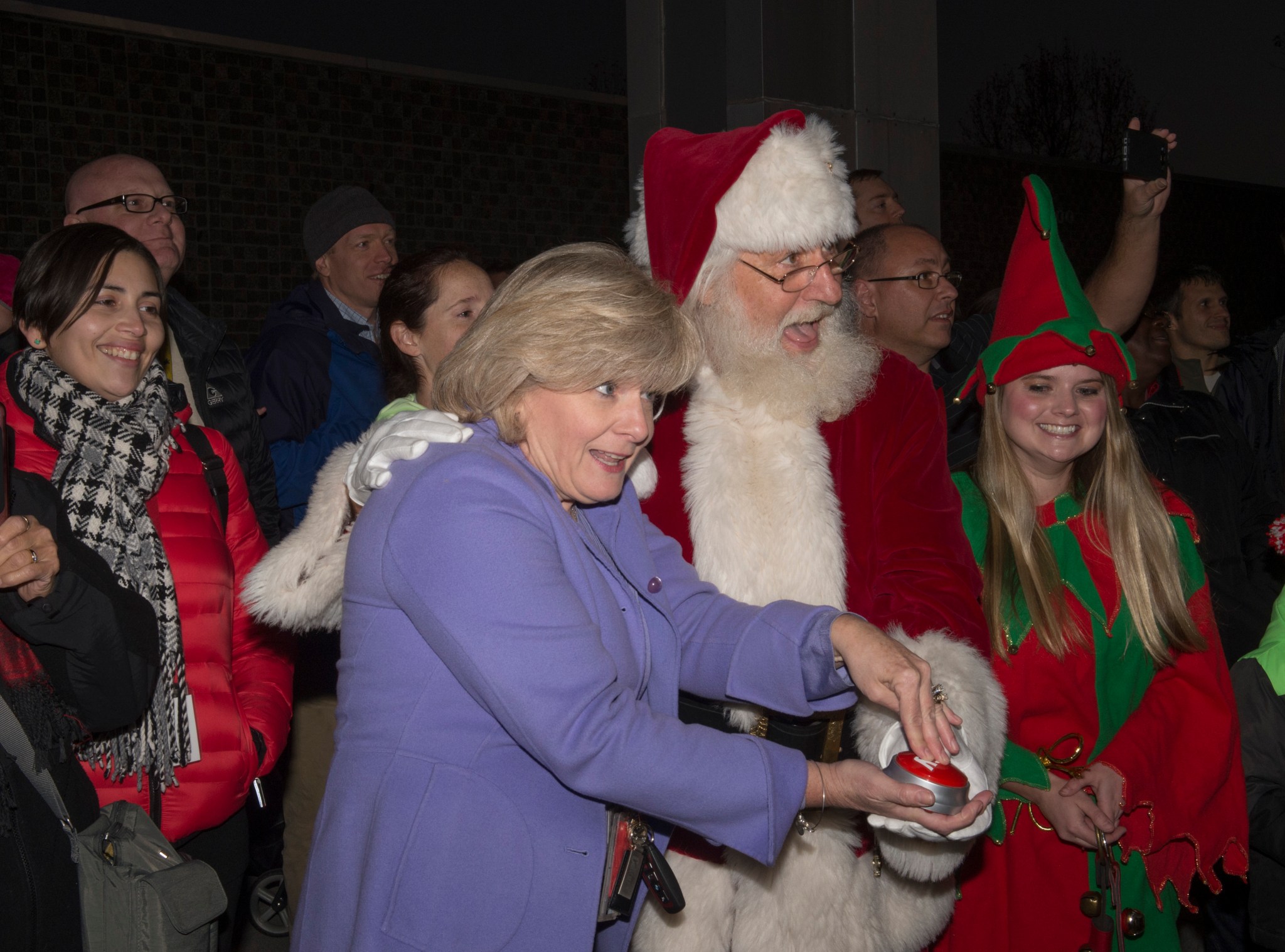
Marshall Space Flight Center Deputy Director Jody Singer, center, receives a helping hand from Santa Claus to officially light Marshall’s holiday tree Dec. 1. Among the merrymaking crowd were Erika Alvarez, far left, lead systems engineer for the Space Launch System Block 1B Vehicle, and Santa’s fellow North Pole emissary “Sparkles the Elf,” right. Children from the Marshall Child Development Center treated the Marshall team to holiday songs and afterward visited with Santa and Sparkles in the lobby of Building 4200. (NASA/MSFC/Emmett Given)
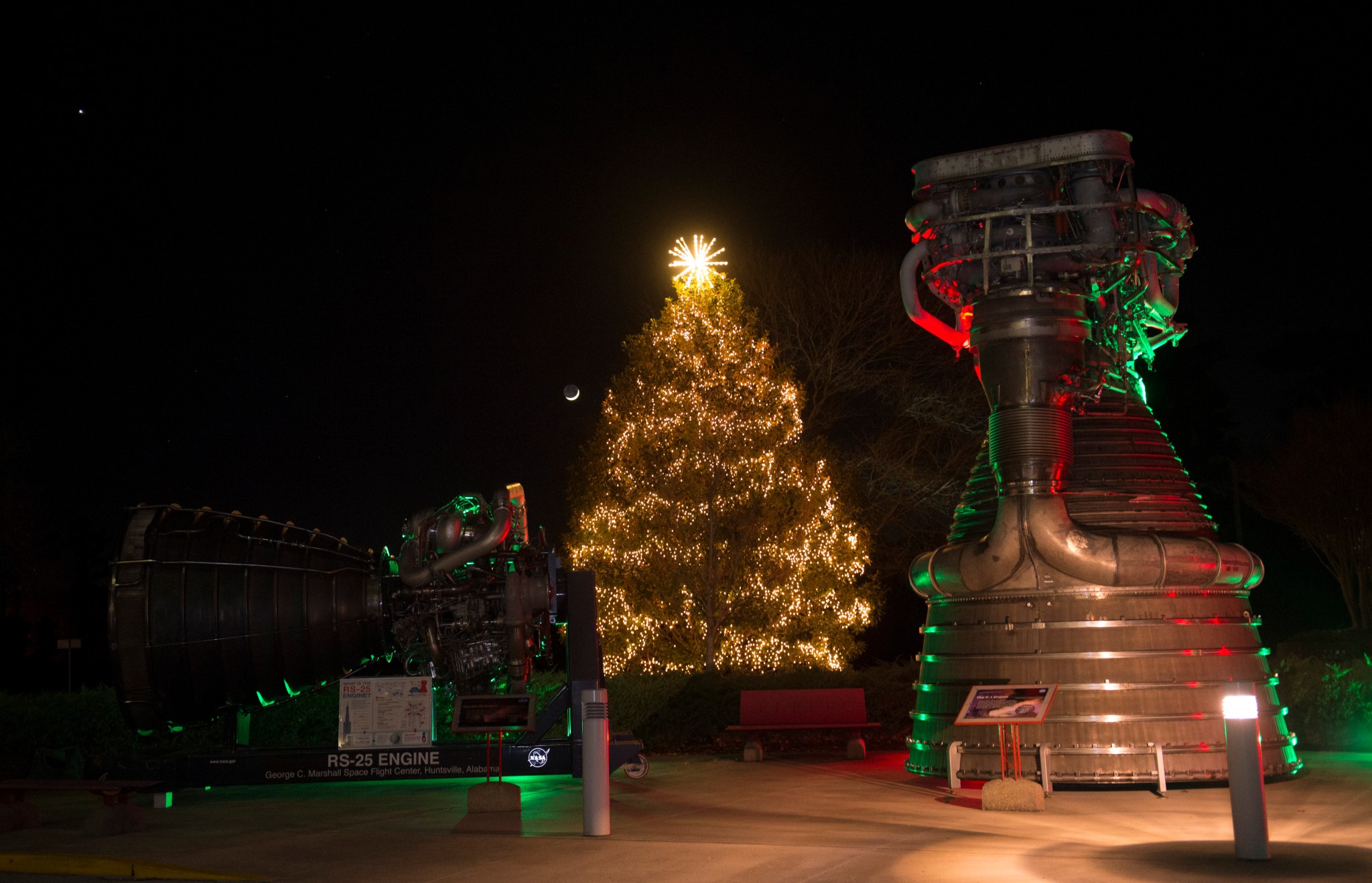
Marshall’s newly lit holiday tree is flanked by iconic NASA rocket engines outside Building 4200, including the RS-25, left, the model that powered the space shuttle to orbit for three decades and next will serve as the core stage engines for NASA’s Space Launch System, and the towering F-1 engine, right, which boosted the Saturn V rocket to the moon during NASA’s Apollo program in the 1960s and ’70s. Though winter is officially still two weeks away, Marshall’s annual tree-lighting combined the warm glow of holiday lights and plunging post-sunset temperatures to create a festive, wintry mood among participating team members and kids. (NASA/MSFC/Emmett Given)
Geminid Meteor Shower to Peak Dec 13; NASA Experts to Answer Questions Dec. 12
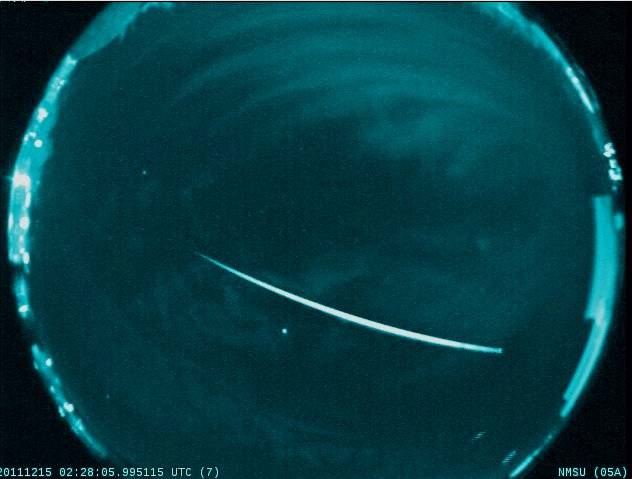
The annual Geminid meteor shower will peak during the overnight hours of Dec. 13-14, with best viewing typically around 2 a.m. To learn why meteors and comets are important to NASA, the public is invited to join a live Reddit Ask-Me-Anything event at 2 p.m. Dec. 12. Answering your questions will be NASA meteor experts Bill Cooke, Danielle Moser and Rhiannon Blaauw, all from NASA’s Meteoroid Environment Office at NASA’s Marshall Space Flight Center. For viewers experiencing clouds, meteor shower footage will be broadcast live from 8 p.m. Dec. 13 until 6 a.m. on Dec. 14 on Marshall’s Ustream account. Social media followers interested in joining the online conversation can tweet questions to Marshall’s Twitter account or share Geminid images by uploading them to the Geminid Meteor photo group on Marshall’s Flickr account. (NASA/MSFC)
Marshall’s John Vickers to Host Webinar, Discuss Additive Manufacturing’s Role at NASA
John Vickers, NASA’s principal technologist in the area of advanced materials and manufacturing, will host a NASA Tech Briefs webinar, titled “The Crucial Role of Additive Manufacturing at NASA,” Dec. 8 at 1 p.m.
With more than 30 years of experience, Vickers — the associate director of the Materials and Processes Laboratory at NASA’s Marshall Space Flight Center and the manager of the NASA National Center for Advanced Manufacturing — leads NASA’s team developing advanced manufacturing technology strategies to achieve the goals of the agency’s missions.
In the webinar, Vickers will discuss the state of NASA’s capabilities, challenges and opportunities in additive manufacturing — a technology that could allow the agency to design and manufacture hardware with new materials at dramatically reduced cost and schedule.
NASA Tech Briefs, a monthly magazine, features exclusive reports of innovations developed by NASA and its industry partners that can be applied to develop new or improved products and solve engineering or manufacturing problems. Authored by the engineers or scientists who did the work, the briefs span a wide array of fields, including electronics, physical sciences, materials, computer software, mechanics, machinery, automation, manufacturing, fabrication, mathematics, information sciences and life sciences.
The webinar will be hosted on NASA Tech Briefs’ webpage. For more information or to view the webinar live at 1 p.m. Dec. 8, click here.
This Week in NASA History: Apollo 17, Final Crewed Mission to the Moon, Launches — Dec. 7, 1972
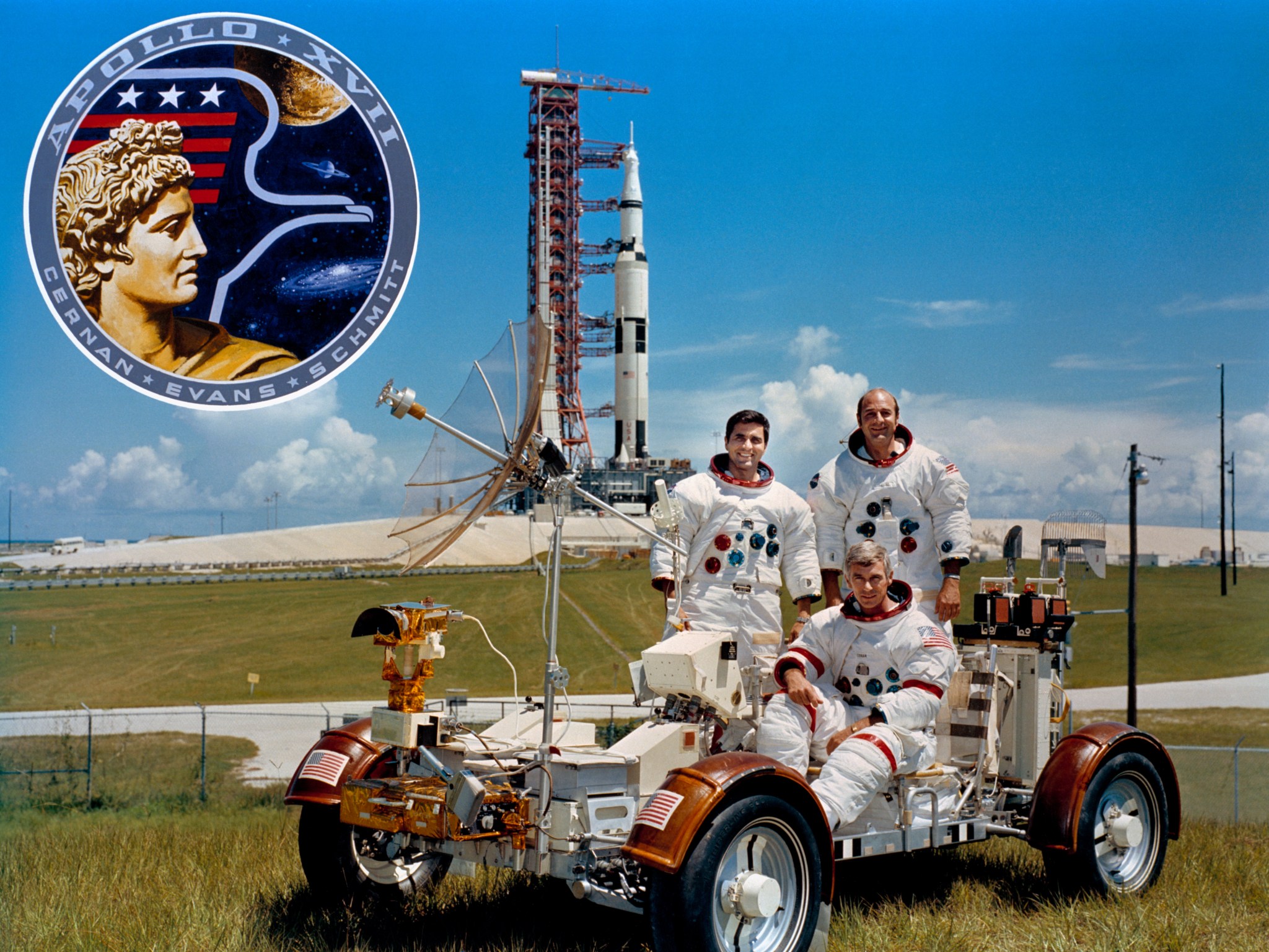
This week in 1972, Apollo 17, the final crewed lunar-landing mission, launched from NASA’s Kennedy Space Center. The scientific mission, which included three days on the lunar surface, was the third to employ the Lunar Roving Vehicle that was developed and managed by NASA’s Marshall Space Flight Center. From left, astronauts Harrison Schmitt, Eugene Cernan and Ronald Evans are photographed with a lunar rover trainer and the mission’s Saturn V rocket, which was also developed and managed by Marshall. Today, Marshall is developing NASA’s Space Launch System, the most powerful rocket ever built that will be capable of sending astronauts deeper into space than ever before, including to an asteroid and Mars. The NASA History Program is responsible for generating, disseminating and preserving NASA’s remarkable history and providing a comprehensive understanding of the institutional, cultural, social, political, economic, technological and scientific aspects of NASA’s activities in aeronautics and space. For more pictures like this one and to connect to NASA’s history, visit the History Program’s webpage. (NASA)







